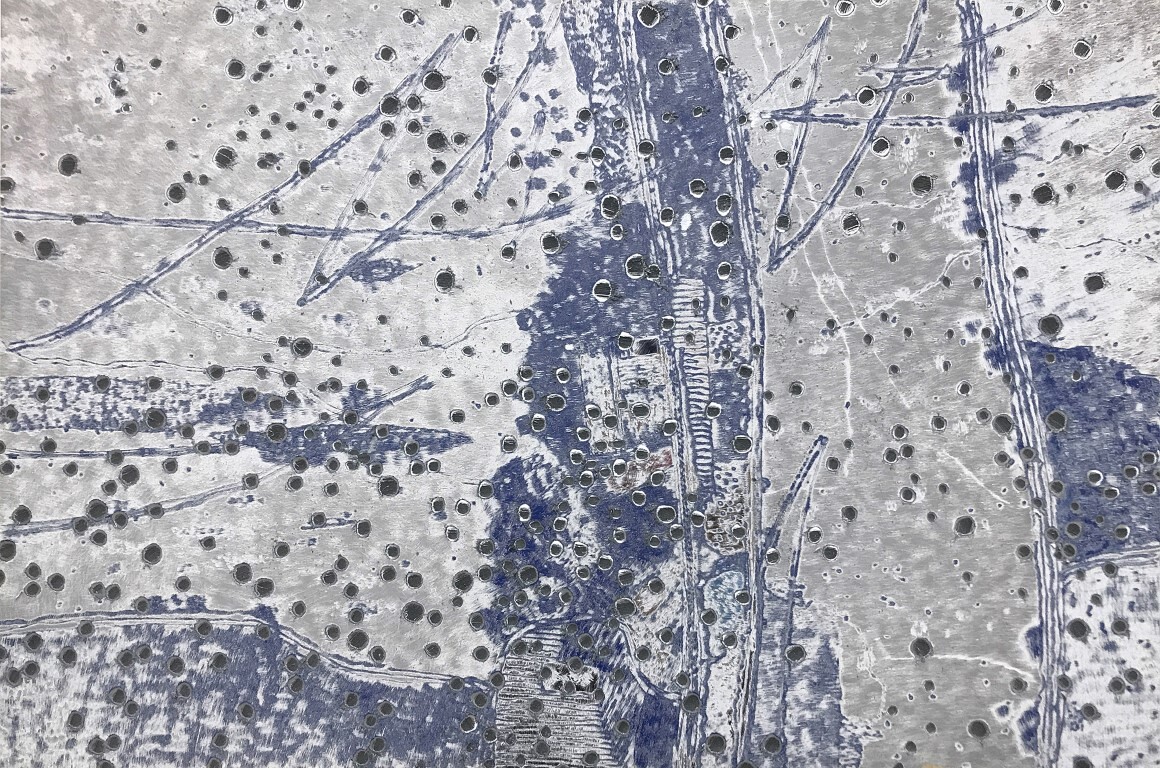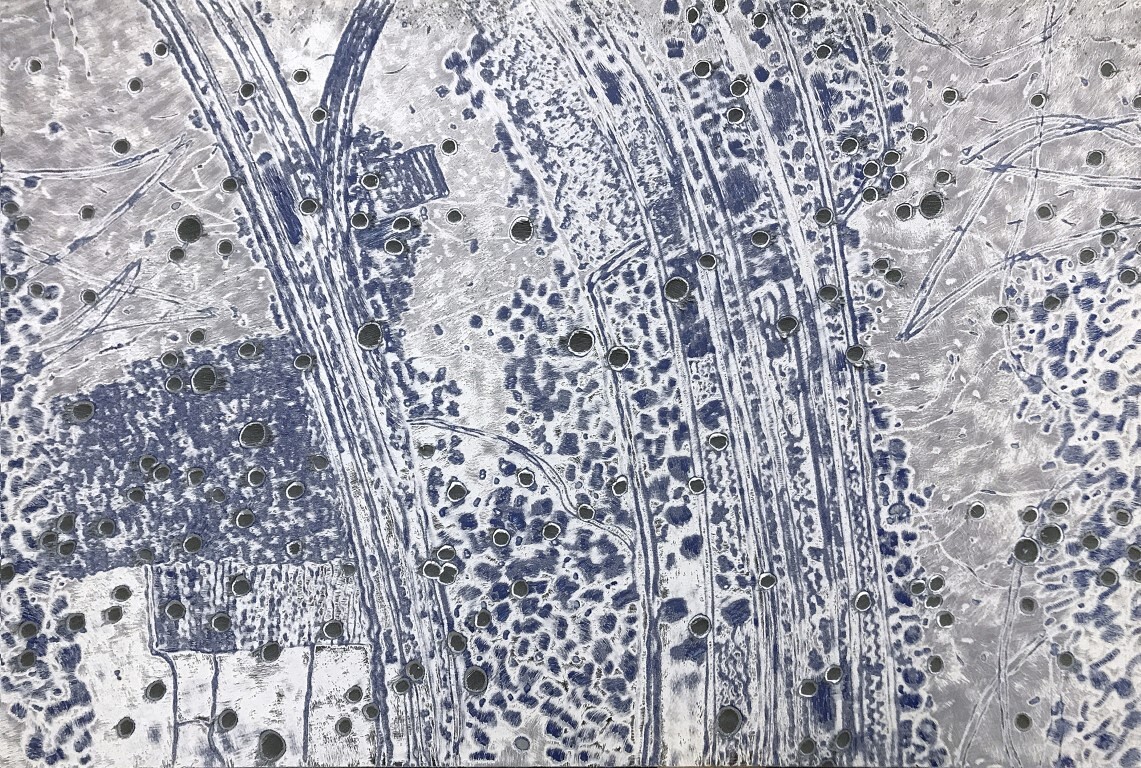

Oleksiy Sai, Bombed 1, 2020, mixed media, 85×128 cm
On April 15, on the fifty-first day of the Russian invasion, Ukrainian artist Sasha Kurmaz wrote on his Facebook page: “In my opinion, the artists currently working in Ukraine can be divided into those who have lost their voice and those who continue to speak actively. Those who actively speak (so far) do not look convincing to me. However, there are also those who try to find words and try to say something at all, but we almost do not hear them.”1 The post immediately received more than a hundred comments, ranging from support to strong disagreement and everything in between. Art in a time of war, a couple of users argued (echoing Kurmaz), has to be solid and convincing, whereas a lack of critical distance and excessive emotivity make it more like a tweet. Here a dimension of obligation in art comes to the fore: everyone is working tirelessly for the common cause of victory, and artists should be no exception. However, what touches me the most in artworks being made and shown nowadays is precisely their emotional nakedness, their capacity to induce empathy, and the sense of unity they create.
Going one step further, I’d like to imagine the future of art and culture in Ukraine after the war. Clearly this can only be loose speculation—one could even say wishful thinking. Nonetheless, it is based on my observations and experience of post-Maidan developments in the arts in Ukraine.
According to Bessel van der Kolk, “We also learn that trauma affects the imagination … When people are compulsively and constantly pulled back into the past, … they suffer from failure of imagination, a loss of mental flexibility. Without imagination there is no hope, no chance to envision a better future, no place to go, no goal to reach.”2 All Ukrainians are deeply traumatized by the ongoing war, whether they live in Ukraine or abroad (like me), whether they have lost loved ones and homes, or have been lucky so far. But hasn’t Ukrainian history in the twentieth century been full of traumatic events? Holodomor, the Holocaust by Bullets, the deportation of the Crimean Tatars, and Chornobyl would suffice, just to name a few. Despite all this, Ukrainian artists and art professionals didn’t seem to suffer a loss of imagination. On the contrary.
For centuries of Ukrainian history, and particularly during the first thirty years of post-Soviet independence, we looked back, trying to reassemble our disrupted and manipulated past piece by piece. This was mostly done via oral history, because a written one barely existed. For instance, the last decade has seen a widespread “decommunization” effort. This became controversial when the conversation turned to a thoughtless demolition of everything labeled Soviet. But the effort has undoubtedly been of utmost importance when it comes to uncovering and restoring historical facts that were hushed up in Soviet times. The same period has also seen the retrieval from nonexistence of the forgotten names of the Executed Renaissance of the 1920s and ’30s. In the mid-2010s we witnessed the archival turn, which inspired many Ukrainian artists to research and evoke Soviet and early post-Soviet history (Nikita Kadan, Daniil Revkovskiy and Andriy Rachinskiy, the De Ne De initiative). All of this has been a proportional response to decades of obliteration, censorship, and oppression (Ukraine opened its Soviet-era KGB archives only in 2015). A lot of effort was made to analyze and to eventually deconstruct Homo Sovietucus and his habitat. These efforts weren’t in vain. They served the purposed of exploring new Ukrainian identities and departing for good from the old one.
In his book Retrotopia, Zygmunt Bauman describes a U-turn that is sometimes performed by the public mind: “from investing public hopes of improvement in the uncertain and ever-too-obviously un-trustworthy future, to re-reinvesting them in the vaguely remembered past, valued for its assumed stability and trustworthiness.”3 This may well describe the current Russian mindset, as much as one can judge from outside, but it’s definitely doesn’t describe Ukraine. There was neither stability nor trustworthiness in our past, so Ukrainians are not hiding there. Instead they are trying to reconstruct and understand it in order to move forward.


Oleksiy Sai, Bombed 3, 2020, mixed media, 74×114 cm
Ukrainian scholar and artist Svitlana Biedarieva, describing tendencies in Ukrainian art, also talks about the documentary turn as “a result of the necessity to record the traumatizing situation and interpret it using documentary art as an interdisciplinary medium.”4 Indeed, documentary practices allow for timely reportage of social and political changes and ensure a wider dissemination, since they mostly employ film, video works, and photography (Mykola Ridnyi, Oleksiy Radynsky, Piotr Armianovski, Oleksandr Glyadelov).
Just as Ukraine once experienced a post-Maidan “cultural Renaissance,” I suppose we will eventually experience a postwar revival. Since the troubled past, both remote and recent, won’t go away, archival and documentary strategies will probably play a central role. I hope, however, that the war reduces the retrospective orientation and opens up a visionary dimension of art. So many Ukrainian cities, as well as people’s microworlds, lay in ruins that we desperately need a vision of new scenarios for the future.
Ironically, the war in Ukraine has finally “opened the borders” and many Ukrainian (mostly female) artists have found themselves abroad, where a wide range of residencies, scholarships, and study opportunities have opened up. Just like many other temporarily displaced Ukrainians, they are eager to return home as soon as possible. When they do, they will undoubtedly bring along new approaches and strategies that must be transformed and applied to the local situation. For instance, it is crucial to develop an ecological analysis of Ukraine today. I don’t just mean the exhaustion of the Ukrainian landscape after decades of thoughtless Soviet extraction and disastrous industrialization. I also mean the ecological impacts of the current war. In front of my eyes right now I can see images of fields full of holes from shelling. In a private conversation, artist Katya Buchatska, who recently went to the outskirts of Kyiv, talked about these holes, many of which are filled with an amalgam of waste, organic matter, and soil that constitute an unknown new substance.
On a practical note, what if after the war the National Union of Artists of Ukraine—a relic of the Soviet system—ceased to exist and all its assets were entrusted to NGOs like the Method Fund, Past/Future/Art, After Silence, or the Territory of Terror Museum in Lviv? The National Union of Artists is a stagnant, corrupt, and unrepresentative organization, whereas these NGOs work tirelessly in the fields of contemporary art, memorial culture, public history, and social anthropology to develop a critical understanding of the past and envision the future of Ukraine. Also worthy of financial support is the Ukrainian Museum of Contemporary Art—which does not currently exist, but which deserves to come into being. Together with the NGOs, this humble museum could reflect and shape a shaken, but not broken, Ukrainian postwar society by carefully preserving and critically examining stories and artefacts.
Alternatively, the extensive network of the National Union of Artists could be decentralized, giving way to a branched network of small local institutions and initiatives working closely with their communities.
After all, the war and everything that comes along with it aren’t new to Ukraine. The eight years of constant tension and fighting in Donbas left an imprint on society but also art, which analyzes, documents, and contests society’s transformations. Of one thing I’m sure: artists will find the words to tell the stories that are waiting to be told. And this storytelling will be an essential tool for coping with multiple traumas. Bessel van der Kolk declares that the only way out of trauma’s muteness is through words, carefully assembled, piece by piece, until the whole story can be revealed. And as Donna Haraway reminds us: “It matters what stories make worlds, what worlds make stories.”5
See →.
Bessel van der Kolk, The Body Keeps the Score: Brain, Mind, and Body in the Healing of Trauma (Penguin, 2014), 17.
Zygmunt Bauman, Retrotopia (Polity, 2017), 6.
Contemporary Ukrainian and Baltic Art: Political and Social Perspectives, 1991–2021, ed. Svitlana Biedarieva (ibidem Press, 2021).
Donna J. Haraway, Staying with the Trouble: Making Kin in the Chthulucene (Duke University Press, 2016).
